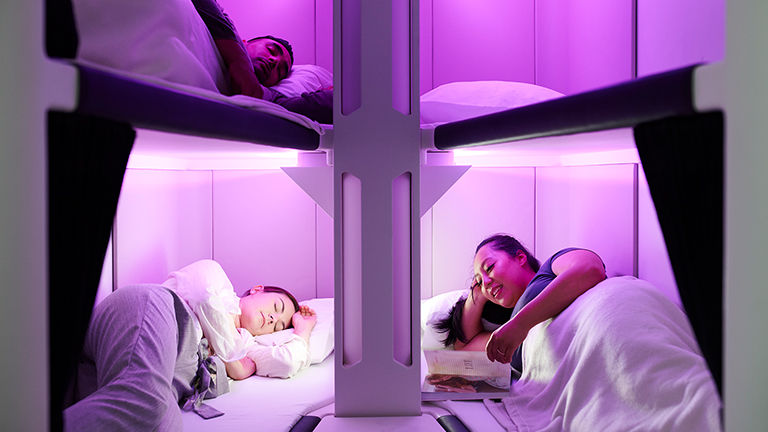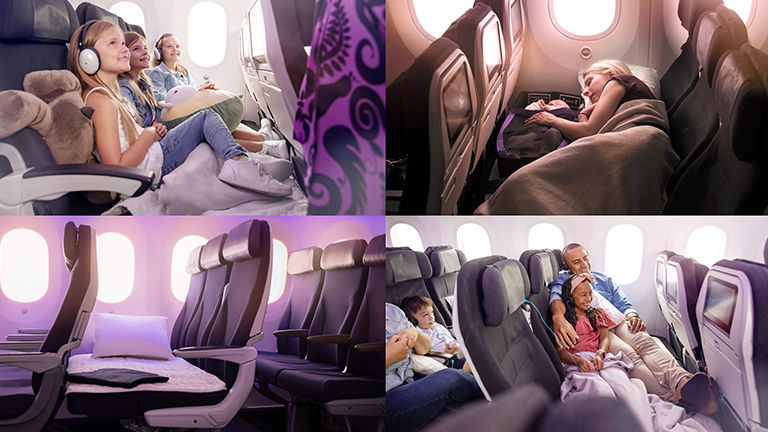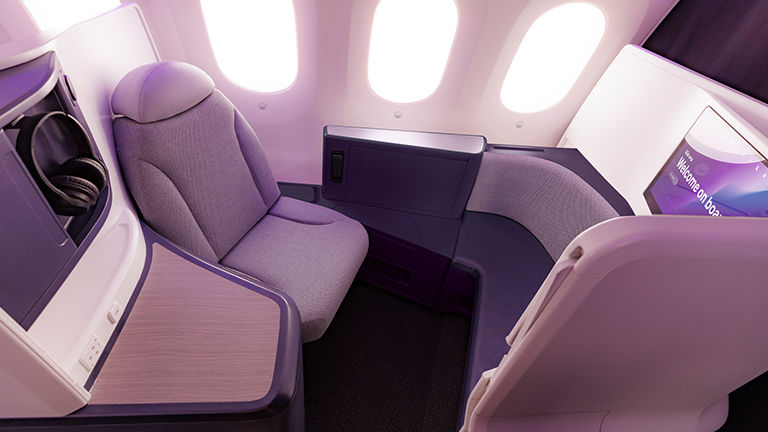It’s not uncommon for airlines to release innovative new offerings in their first- or business-class cabins in an effort to impress and attract luxury travelers. What’s less common, perhaps, is seeing that kind of forward-thinking attitude about seating in economy class.
At Air New Zealand, however, the team is making enhancements throughout the plane, including the upcoming Skynest, a first-of-its-kind offering slated to debut in the second half of 2025 on its new B787-900 Dreamliner. Skynest will offer six private sleep pods in a bunk-bed configuration, which passengers can book for a four-hour, lie-flat sleep session during ultra-long-haul flights for an estimated cost of $250-$400.
Even before that industry-first option arrives, the airline is introducing its new Business Premier Luxe product later this year, as well. A reconfiguration of the first four seats in business class will create more space and more privacy for guests, complete with a small gathering space where a pair of guests can share a meal (at an actual table), enjoy a drink and otherwise socialize together.
We spoke with Ben Evers-Swindell, general manager for the Americas at Air New Zealand, to find out more about these upcoming offerings, as well as its approach to other onboard classes of service.
What inspired Air New Zealand to do something so innovative in its economy-class cabin?
This is maybe my own personal opinion, but New Zealand’s culture is quite naturally egalitarian. And to me, that culture really flows through to our business, to the design of our aircraft and to the way that we interact with our passengers. We pride ourselves on and are very specific about the investment we make in all cabins, but in particular, the difference in our focus on the economy cabin. And, given the typical international distance that's traveled [to and from New Zealand], it's important that we provide additional comfort and support for those economy passengers.
We pride ourselves on and are very specific about the investment we make in all cabins, but in particular, the difference in our focus on the economy cabin.
Tell us a bit about the upcoming Skynest concept.
We're launching Skynest on our brand-new Dreamliner that, all going well, we'll be taking delivery of late next year. (It has been slightly delayed because it is a Boeing aircraft.) It will be a special configuration that's designed for ultra-long-haul flying on our Auckland to New York service.
 Skynest bunks will be available to book in four-hour periods.
Skynest bunks will be available to book in four-hour periods.
Credit: 2024 Air New ZealandThe Skynest is six bunks, three layered on top of one another — and the idea is to give some of those economy and premium-economy passengers the opportunity to have a period of time when they can lie flat and get some rest in four-hour blocks. Those bunks will have their own air vents; their own lighting; and a pillow, a sheet and a blanket (which will, of course, be changed between seatings). They will also have specially designed lighting to wake people up gently in between those periods.
And the idea for Skynest was partially driven by guest feedback, correct?
Very much so. Especially with longer-haul flying, sleep and rest are most important to a majority of our passengers. And one of the most important elements for rest is the ability to lie flat. That's the overwhelming feedback from our customers.
There was also a lot of consultation that went into the design for this new aircraft: 170,000 hours over five years. So, there's been no shortage of consultation with customers, with sleep experts and [with other specialists].
While not new, Skycouch is another innovative economy offering. Tell us a little about that product.
Skycouch has been a loyal servant for us since 2010. It’s an innovative product that’s patented to Air New Zealand. And again, the core principle behind it is the opportunity for people to lie flat. We have set rows in our economy cabin with a foot rest that will actually come up to match the alignment of the seats. All of the armrests can come up (even the armrests up against the window), so you can actually lean back on it like it's a couch, [or lie down across it].
 Skycouch can be configured in different arrangements to meet the needs of travelers.
Skycouch can be configured in different arrangements to meet the needs of travelers.
Credit: 2024 Air New ZealandThe initial design was actually for couples to lie in a spoon-like fashion. But where we have found it's been most popular is with families with young children, where parents prioritize the ability for their children to lie down and have a decent sleep. So, you might have an adult sitting upright with a child or two lying down next to them. Or you might have a parent lying down with a child, as well. The configuration options vary depending on the requirements.
It has also been very popular with solo travelers, who will book out the whole row.
Moving up the plane, Business Premier Luxe is the other product that's upcoming, right?
Business Premier Luxe is part of our new aircraft design. Now, the good news about Business Premier Luxe and the rest of the new Business Premier cabin layout is that we will actually be rolling the offering out at the end of this year as part of our retrofit.
And that whole cabin design is inspired by New Zealand/Aotearoa’s forest. The idea is that our passengers will feel like they're walking into New Zealand as soon as they step onboard the aircraft. There's also a sustainability focus: We're using modern fabrics instead of leather. That reduces weight and fuel burn, and subsequently, carbon emissions.
And the crowning product is Business Premier Luxe, where we are better utilizing the front four seats of the cabin (where a lot of space historically has been used for stowage). Now, we’re offering additional space and comfort to passengers in those front four seats. It provides a little more privacy, a little more space. And this is the most upscale product that we've had in our business class.
 Business Premier Luxe will debut later this year in retrofitted cabins.
Business Premier Luxe will debut later this year in retrofitted cabins.
Credit: 2024 Air New ZealandYou also have the ability for another companion to sit with you. You can't travel together through takeoff and landing, but in flight, when the seatbelt sign is not on, you can sit together and even have a meal together.
Are there any changes coming to Premium Economy?
We have won a number of awards for our Premium Economy product. There's not going to be major changes because it has been very successful and is very popular. But the seat pitch will actually be moving within an encased frame, so there's no impact on the passenger behind you if you're putting your seat backward or forward. And we’ll have larger screens there, as well.
But the best way to describe our Premium Economy — because some carriers’ premium economy is an extension of economy — is as a slight step down from business class. It is a very well-serviced cabin. We serve business-class meals to Premium Economy passengers. You get the same headphones that are provided to Business Premier passengers. The look and feel of the whole experience is very similar, and you're getting that upscale service offering, which is quite possibly the reason we win so many awards in that cabin. It exceeds a lot of customers’ expectations.
Any other noteworthy developments that you can share?
One of the other major innovations is that we will be one of the first airlines in the world to launch Starlink internet. We will be commencing trials early next year [on a domestic aircraft] and, should those trials be successful, we will look to roll that out across our entire fleet. And where that's incredibly valuable from a passenger perspective is you will be able to stream your own content.
The other thing we are rolling out, along with other carriers in North America, is biometric, automated boarding. So, we’re very much keeping up with the technology in that respect.